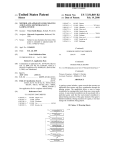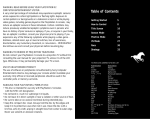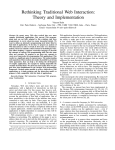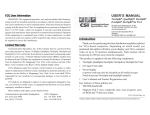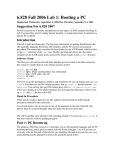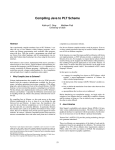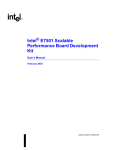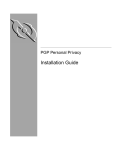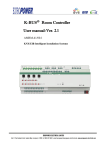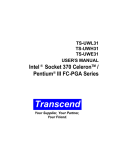Download Method and apparatus for secure execution using a secure memory
Transcript
US006986052B1 (12) (54) 75 ( ) (73) United States Patent (10) Patent N0.: Mittal (45) Date of Patent: METHOD AND APPARATUS FOR SECURE EXECUTION USING A SECURE MEMORY PARTITION _ . Inventor. . . Mllllnd Mlttal, Palo Alto, CA (US) . Ass1gnee: Intel Corporation, Santa Clara, CA , ( ) ( 21 ) _ Notice: A pp _ _ 1056014 A1 2000-76139 A WO 97/29567 A1 W0 WO 98/34365 A1 8/1997 8/1998 W0 WO 98/44402 A1 _ 10/1998 W0 WO 01/27723 A1 10/2000 4/2001 WO 01/27821 A2 4/2001 W0 WO 01/75564 A2 10/2001 W0 WO 01/75565 A2 10/2001 100001 SubJect to any disclaimer, the term of this W0 W0 O1/75595 A2 patent is extended or adjusted under 35 W0 WO 02/17555 A2 2/2002 U.S.C. 154(b) by 930 days. W0 W0 02/086684 A2 10/2002 W0 W0 03/058412 A2 7/2003 l. N .: 09 608 439 0 / (22) Filed? 11/2000 3/2000 WO 00/62232 A1 W0 (Us) * Jan. 10, 2006 EP JP W0 W0 . US 6,986,052 B1 ’ OTHER PUBLICATIONS Jun- 30! 2000 Berg, Cliff, “HoW Do I Create a Signed Applet?”, Dr. Dobb’s Journal, Aug. 1997, 1-9. (51) Int‘ Cl‘ Brands, Stefan, “Restrictive Blinding of Secret-Key H041‘ 9/32 (200601) Certi?cates”, CWI, 1995, 1-35, Springer Verlag, (52) US. Cl. ..................................... .. 713/190; 713/189 Amsterdam, The Netherlands (58) Field of Classi?cation Search .............. .. 713/190, ' ~ 713/188, 189, 193'; 711/163 Chien, Andrew A_ & Byun, Jay H_, “Safe and Protected Execution for the Morph/AMRM Recon?gurable Proces See application ?le for complete search history. 501"”, 7th Annual IEEE Symposium, FCCM ’99 Proceedings, _ (56) ISBN 0-7695-0375-6, Los Alamitos, CA. References Clted Coulouris, George, Dollimore, Jean, Kindberg, Tim, “Distributed Systems: Concepts and Design” ’ Queen Mary U.S. PATENT DOCUMENTS _ and West?eld College University of London, 1998, 422-424, 4,573,119 A * 2/1986 Westhelmef et a1- ~~~~~~ -- 713/190 5,249,232 A * 9/1993 Erbes etal. .............. .. 713/190 5,471,599 A * 11/1995 Brodnax et a1. 5,991,399 A * 11/1999 Graunke et al. 6,012,141 A * 1/2000 2nd ed., Addison-Wesley Publishing Ltd., Essex, England. 711/202 380/279 _ (contlnued) Primar Examiner_Jus?n T Darrow Isaman ..................... .. 712/244 6,061,449 A * 5/2000 Candelore et a1. .......... .. 380/28 6,651,171 B1 * 11/2003 England et al. ........... .. 713/193 y _ ' (74)An0me% Agent» 0’ F”'”—KenY°n & Kenyon (57) ABSTRACT FOREIGN PATENT DOCUMENTS DE EP 42 174449 A1 0473913 A2 12/1992 3/1992 EP 0600112 A1 6/1994 EP 0892521 B1 1/1999 EP 0930567 A2 7/1999 EP 1030237 A1 8/2000 EP 1055989 A1 11/2000 _ A processor capable of secure execution. The processor contains an execution unit and secure partition logic that secures a partition in memory. The processor also contains . . . cryptographic logic coupled to the execution unit. that encrypts and decrypts secure data and code. 19 Claims, 5 Drawing Sheets SECURE PARTITION REGISTERS 214 REGISTER CRYPTOGRAPHIC FILES LOGIC @ 2_1_9 SECURE DATA ----- 2g _ I ---- -- _____ __ 355005560005 SECURE PARTITION “5%.?” E _ ENFORCBAENT LOGIC 2L3 BOOTSTRAP SECURITY LOGIC 241 '* ON-CHIP BIOS 215 _‘ \_/\/\ PROCESSOR KEY STORAGE SYSTEM "94°91 29 ELEMBIT 21_s PROCESSOR 21_0 SECURE MEMORY PARTITION 223 US 6,986,052 B1 Page 2 Techniques”, (last modi?ed Nov. 29, 1999) <http://WWW. OTHER PUBLICATIONS Crawford, John, “Architecture of the Intel 80386”, IEEE, plex86.org/research/paper.txt>. tions of the ACM, Jul. 1974, 403-412, vol. 17, No. 7, Luke, Jahn, Bittorie, John W., Cannon, William J., Halde man, Douglas G., “Replacement Strategy for Aging Avion ics Computers”, IEEE AES Systems MagaZine, Mar. 1999. MeneZes, Alfred, Van Oorschot, Paul, Vanstone, Scot A., “Handbook of Applied Cryptography”, CRC Press LLC, 1997, 403-405, 475, 506-515, 570, ISBN: 0-8493-8523-7. Association for Computing Machinery. Frieder, Dr. Gideon, “The Architecture and Operational Nanba, S., Ohno, N., Kubo, H., Morisue, H., Ohshima, T., Characteristics of the VMX Host Machine”, IEEE, 1982, Yamagishi, 9-16. Architecture”, IEEE, 1985, 171-178. Richt, Stefan, Hamm, Peter, “In-Circuit-Emulator Wird ‘EchtZeittauglich’”, Elektronik, Aug. 6, 1991, 100-103, No. Jan. 1986, 155-160. Davida, George I., Desmedt, Yvo G., Matt, Brian J., “Defending Systems Against Viruses through Cryptographic Authentication”, IEEE, Jul. 1989, 312-318. Fabry, R.S., “Capability-Based Addressing”, Communica Goldberg, Robert P., “Survey of Virtual Machine Research”, Computer, Jun. 1974, 34-45, vol. 7, No. 6. Gong, Li, Mueller, Marianne, Prafullchandra, Hemma, Schemers, Roland, “Going Beyond the Sandbox: An OvervieW of the NeW Security Architecture in the Java Development Kit 1.2”, USENIX Symposium on Internet Technologies and Systems, Dec. 1997. Gum, P. H., “System/370 Extended Architecture: Facilities for Virtual Machines”, IBM J. Res. Develop., Nov. 1983, 530-544, vol. 27, No. 6. Heinrich, Joe, “MIPS R4000 Microprocessor User’s Manual”, 61-97, 2“d ed. HeWlett-Packard Company, “Mobile Security OvervieW”, Sep. 2002, 1-9. IBM Corporation, “IBM ThinkPad T30 notebooks”, IBM, Apr. 2002, USA. IBM Corporation, “Information Display Technique for a Terminate Stay”, IBM Technical Disclosure Bulletin, Dec. 1991, 156-158, vol. 34, No. 7A, USA. Intel Corporation, “IA-32 Intel Architecture SoftWare Developer’s Manual—vol. 3: System Programming Guide”, 2003. Intel Corporation, “IA-64 System Abstraction Layer Speci?cation”, Jan. 2000, pp. 1-1 to 3-21. Intel Corporation, “Intel 82802AB/82802AC FirmWare Hub (FWH)”, Nov. 2000, 17-28. Intel Corporation, “Intel386 DX Microprocessor 42-BIT CHMOS Microprocessor With Integrated Memory Manage ment”, Dec. 1995. Karger, et al., “A VMM Security Kernel for the VAX Architecture”, IEEE May 1990, 2-19. KashiWagi, KaZuhiko, Saisho, KeiZo, Fukuda, Akira, “Design and Implementation of Dynamically Reconstruct ing System SoftWare”, IEEE, Aug. 1996. LaWton, Kevin P., “Running Multiple Operating Systems Concurrently on an IA32 PC Using VirtualiZation Motorola Inc., “M68040 User’s Manual”, Motorola, 1990. H., “VM/4Z ACOS-4 Virual Machine 16, Munich, Germany. Robin, John Scott, Irvine, Cynthia E., “Analysis of the Intel Pentium’s Ability to Support a Secure Virtual Machine Monitor”, 9th USENIX Security Syposium, Denver, Colorado, Aug. 14-17, 2000. Rosenblum, Mendel, “VMWare’s Virtual Platform: AVirtual Machine Monitor for Commodity PCs”, Hot Chips 11 conference, Palo Alto, CA, Aug. 15-17, 1999. RSA Security Inc., “HardWare Authenticators”, (2004) <http://WWW.rsasecurity.com/node.asp?id-1158>. RSA Security Inc., “RSA SecurlD Authenticators: The gold standard in tWo-factor user authentication”, 2003, SID DS 0103. RSA Security Inc., “SoftWare Authenticators”, (2004) <http://WWW.rsasecurity.com/node.asp?id-1313>. SaeZ, Sergio, Vila, Joan, Crespo, Alfons, Garcia, Angel, “A HardWare Scheduler for Complex Real-Time Systems”, IEEE, Apr. 1999, 43-48, ISIE;99—Bled, Slovenia. Schneier, Bruce, “Applied Croptography”, 1996, 28-33, 47-52, 56-65, 176, 177, 169-187, 216, 217, 461-473, 518 522, 2nd ed., ISBN 0-471-12845-7, John Wiley & Sons. SherWood, Timothy, Calder, Brad, “Patchable Instruction ROM Architecture”, CASES’01, Nov. 16-17, 2001, Atlanta, GA, 24-33. Trusted Computing Platform Alliance (TCPA), “Main Speci?cation Version 1.1a”, Compaq Computer Corpora tion, HeWlett-Packard Company, IBM Corporation, Intel Corporation, Microsoft Corporation, Dec. 1, 2001, 1-321. Trusted Computing Platform Alliance (TCPA), “Main Speci?cation Version 1.0”, Compaq Computer Corporation, HeWlett-Packard Company, IBM Corporation, Intel Corporation, Microsoft Corporation, Jan. 25, 2001, 123-227. * cited by examiner U.S. Patent Jan. 10, 2006 vEomz Sheet 1 6f 5 US 6,986,052 B1 To: _ on \ a \ \ 5% . 2 5 0 H \U V02 Emagmoa: Q: I/ / a |.I|II|/IIlIIlIlI .8520m 2: mowm mwSzo o2 _ or 8A25 28 U.S. Patent US 6,986,052 B1 w. m5: 9/-2 /m, Q58% /J/ 5E:02- ///H.%EW 2» /m52//03:5% 5Ean05: 855EQ 2“%2%; U.S. Patent Jan. 10, 2006 Sheet 4 6f 5 US 6,986,052 B1 EXAMINE AN INSTRUCTION PRIOR TO EXECUTION OF ~/“4O1 THE INSTRUCTION 402 IS THE INST. AN INST. OUTSIDE THE SECURE NO PARTITION THAT OPERATES 0N DATA WITHIN THE PARTITION YES 9 403 IS THE INST. A BRANCH FROM OUTSIDE THE PARTITION TO A LOCATION WITHIN THE PARTITION OTHER THAN AN ENTRY POINT 9 404 II II IS THE INST. NOT AN ENTRY POINT AND THE PREVIOUS INST. EXECUTED WAS THE INST. IMMEDIATELY BEFORE THE BEGINNING OF THE PARTITION '2 TRAP TO TRAP HANDLER $406 EXECUTE THE 405 _/~ INSTRUCTION END FIG.4 U.S. Patent Jan. 10,2006 Sheet 5 Ms US 6,986,052 B1 READ AN ENCRYPTED INST. INTO A PROCESSOR FROM A SECURE ,JOI PARTITION IN A MEMORY I DECRYPT THE INSTRUCTION READ 502 THAT READS DATA FROM A SECURE READ THE DATA FROM THE SECURE PARTITION AND DECRYPT THE DATA READ 505 SECURE PARTITION ? ENCRYPT THE DATA AND WRITE THE DATA TO THE LOCATION IN THE SECURE PARTITION END FIG.5 US 6,986,052 B1 1 2 METHOD AND APPARATUS FOR SECURE EXECUTION USING A SECURE MEMORY PARTITION DESCRIPTION OF THE DRAWINGS FIG. 1 is a partial block diagram of a computer system capable of secure execution according to an embodiment of the present invention. FIG. 2 is a partial block diagram of a processor having FIELD OF THE INVENTION secure execution components and a memory With a secure Embodiments of the present invention relate to secure execution in a processor. In particular, the present invention relates to a method and apparatus for secure execution using partition according to an embodiment of the present inven tion. FIG. 3 is a partial block diagram of virtual and physical a secure memory partition. memory partitions. FIG. 4 shoWs a How chart of a method of processing an BACKGROUND instruction according to an embodiment of the present invention. FIG. 5 shoWs a How chart of another method of process ing an instruction according to an embodiment of the present invention. The tremendous increase in connectivity of computers has increased the importance of a robust security infrastructure. A computer system’s security features can be used to prevent unauthoriZed access (e.g., from the Internet). A secure execution environment that preserves the privacy and integrity of transactions is important to enable the use of DETAILED DESCRIPTION Internet based commerce. A secured execution environment Embodiments of the present invention provide for secure execution by storing sensitive code and data in a secure memory partition. The sensitive code and data may include could also be used to provide copy protection for published softWare or content (e.g., movies) stored on media like Digital Versatile Disks (DVDs) or Compact Disk-Read Only Memories (CD-ROMs). Securing execution includes ensuring the integrity of the the code and data used to verify the authenticity and integrity 25 of transmissions received over a netWork and may include content stored on a media such as a DVD or CD-ROM. A execution and ensuring the privacy of code and data. Various secure memory partition may be de?ned by the architecture types of threats may lead to a compromise of the integrity or privacy of a system. For example, malicious softWare may be able to exploit Weaknesses in the operating system. Direct memory access devices may be able to read physical memory Without processor support. A logic analyZer may be used to observe the traf?c betWeen the processor and the memory. Attacks may also be made Which take advantage of a processor’s built-in debug mode or probe mode or Which physically modify the connectivity of components in the 35 system to observe and modify the communication betWeen the components. An attacker could also subject the hardWare to an abnormal voltage, temperature or frequency so as to compromise the execution of the system and possibly cause hardWare to “leak” out secrets. In addition, an attacker could 40 remove the process layers selectively to expose the device structures hiding the secrets or use an Ion beam to examine the How of signals inside the device. Some security schemes, such as those based on public/ private key cryptography, uses private data or code that needs to be kept secret. In several cases, the encoding as an address range Within the general address space of the processor. The partition may be an address range of virtual memory locations or physical memory locations. The address range may be speci?ed by a base address and a range. The secure memory partition may have a ?xed entry point. In a further embodiment, the sensitive code and data is encrypted by hardWare on the processor before it is Written to the memory, and decrypted after it is read back into the processor, to protect the sensitive code and data from disclosure. Different embodiments of this invention provide protection against different levels of threats. Embodiments provide a high degree of protection against attacks based on malicious softWare, intelligent I/O devices, attacks using a logic analyZer, and hardWare attacks that comprise de socketing of the processor and then placing it in an integrity compromised platform. 45 Embodiments of a Secure Execution System FIG. 1 is partial block diagram of a computer system algorithm used is publicly knoWn, and the strength of the cryptography is in keeping the key secret. Intermediate data, capable of secure execution according to an embodiment of the present invention. Computer 100 contains components 101, Which may include a processor 110, chipset 102, system such as the control How information of the program, should not be exposed because it may make it easier to determine memory 120, netWork interface card 103, non-volatile mass the private key. In this regard, conditional assignment capa storage 104, input/output (I/O) device 107, and basic input/ bility of a processor architecture may be used to eliminate branches on the secret data, but it is difficult to design code to meet this requirement. For some applications, part of the output system (BIOS) ROM 108. The processor 110 may be coupled to the chipset 102. The term “coupled” encompasses 55 cryptographic strength is in the privacy of the algorithm itself. In this case, the execution environment needs to guarantee that even the execution code, along With the input data and all intermediate results, is kept private. over a bus or busses such as a system bus, peripheral In some systems, a special security coprocessor is used to protect the code and data of a host processor. KnoWn systems do not provide an effective means for a host processor to protect the private code or data (e.g., a key) Within the host processor against attacks that use, for example, malicious softWare, direct memory access devices, a direct connection, an indirect connection, an indirect communication, etc. Chipset 102 may also be coupled to system memory 120, netWork interface card 103, non volatile mass storage 104, input/output device 107 and BIOS ROM 108. These devices may be coupled to chipset 102 component interface (PCI) bus, etc. NetWork interface card 103 may be coupled to a netWork 130. Computer 100 may also contain additional components such as a co-processor, 65 modem, etc. Processor 110 may be a general purpose microprocessor logic analyZers, exploit the system debug/probe mode, or such as a PENTIUM class processor manufactured by Intel modify the hardWare to reveal secrets. Corp. of Santa Clara, Calif. In another embodiment, the US 6,986,052 B1 3 4 processor can be an Application Speci?c Integrated Circuit erator unit 217 utiliZes statistical phenomenon in physical (ASIC), controller, micro-controller, etc. Chipset 102 may devices (thermal noise, for example) to provide random be one or more integrated circuit chips that acts as a hub or numbers. In this embodiment, execution units 211 may also be core for data transfer betWeen the processor and other components of the computer system. In an embodiment, chipset 102 includes a memory control hub (MCH), Which performs What is knoWn as “northbridge functionality,” and an input/output controller hub (ICH), Which performs What is knoWn as “southbridge functionality.” System memory 120 is any device adapted to store digital information, such coupled to secure partition enforcement logic 218 Which contains the logic to manage a secure partition in a memory or memories as described beloW. In a further embodiment, secure partition enforcement logic 218 is coupled to an cryptographic logic 219 Which encrypts information that is 10 as a dynamic random access memory (DRAM), a static random access memory (SRAM), etc. or any combination thereof. In an embodiment, system memory 120 is a volatile memory. Processor 110, chipset 102, system memory 120, and BIOS ROM 108 may be mounted on a system mother 15 board in computer 100. to be stored in a secure partition and decrypts information that is read from a secure partition. Cryptographic logic 219 may be hardWare logic that implements an algorithm such as Data Encryption Standard (DES), Rivest-Shamir-Adleman (RSA), or Digital Signal Standard (DSS) encryption. In one embodiment, the cryptographic logic 219 uses a platform speci?c key rather than the processor keys stored in proces sor key storage element 216. Secure partition enforcement logic 218 and cryptographic logic 219 may be coupled to a translation look-aside buffer (TLB) 213 Which may be used Network interface card 103 may contain logic to com municate using a standard netWork protocol. Network 130 may be a local or Wide area computer netWork and may be, for example, an intranet or the Internet. Non-volatile mass storage 104 may be any device or devices adapted to store digital information, such as ?ash memory, a hard disk, an to match virtual addresses in the address space of processor 210 to physical addresses in system memory 220 and in other memories accessed by processor 210. FIG. 2 also shoWs system memory 220 containing a secure memory partition 223. Secure memory partition 223 optical digital storage device, a magneto-electrical storage device, DVD, CD-ROM, etc., or any combination thereof. FIG. 1 shoWs non-volatile mass storage 104 as including an 25 may be a section of physical memory or virtual memory that optical storage 105 and a ?oppy drive 106. Input/output is only accessed by code residing in the secure partition. In device 107 may be a keyboard, mouse, display screen, printer, etc. or any combination of thereof. BIOS ROM 108 may contain the code to control peripheral devices such as a keyboard, display screen, disk drives, serial communica tions. BIOS ROM 108 may also contain code that is used to one embodiment, secure partition 223 may be de?ned by tWo secure partition registers 214. For example, secure partition 223 may be de?ned by a secure partition virtual address base register, Which species the start of the secure partition in virtual memory, and a secure partition virtual perform other miscellaneous functions. address range register, Which speci?es the size of the secure partition. In FIG. 2, secure partition 223 is shoWn mapped to physical addresses in system memory 220. Secure memory FIG. 2 is a partial block diagram of a processor having secure execution components and a memory With a secure partition according to an embodiment of the present inven 35 tion. FIG. 2 shoWs a processor 210 and a system memory 220 Which are part of a computer system such as, for store, for example, trusted veri?cation enforcement instruc tions 242 Which are used to apply cryptography algorithm example, the computer system 100 shoWn in FIG. 1. Pro and verify the authenticity and integrity of transmissions cessor 210 and a system memory 220 may be the same as processor 110 and system memory 120 of FIG. 1. Processor partition 223 may contain a secure data section 225 and a secure code section 226. The secure code section 226 may 210 may be coupled to system memory 220, for example, received over a netWork (or of content stored on a media such as a DVD or CD-ROM). Secure data section 225 may through a chipset such as chipset 102 of FIG. 1. Processor 210 may contain execution units 211, such as contain data used by the secure code, such as private keys and intermediate data (e.g., control How information of the 40 for example an arithmetic logic unit, Which may be coupled to register ?les 212. Register ?les 212 may include a secure instructions). Secure code section 226 may have an 45 entry point 228, Which may be used as described beloW. plurality of registers such as general purpose registers, ?ag The embodiment shoWn in FIG. 2 may operate as folloWs. registers, an instruction pointer, index registers, etc. or a combination thereof. Register ?les 212 may include secure The processor 210 ensures the integrity of the platform by authenticating the BIOS code (e.g., in BIOS ROM 108) by using bootstrap security logic such as processor microcode partition registers 214. Execution units 211 may be coupled to a on-chip basic input/output system (BIOS) 215, proces sor key storage element 216, and random number generator (RNG) unit 217. On-chip BIOS 215 may contain burned-in logic that is used by the processor to communicate With other system components, such as system memory 120, and may contain the logic run When the processor is initiated or on-chip BIOS veri?cation ?rmWare code Which is shoWn in FIG. 2 as bootstrap security logic 241. The secure BIOS 108 then in turn validates the presence of any other protec tion mechanisms in the chipset. According to an embodi ment, When processor 210 is booted-up, it may create a 55 (booted up). This logic may include bootstrap security logic location for the secure partition. The processor may then program a secure partition base register and secure partition 241 as described beloW. In addition, on-chip BIOS 215 may contain logic (e.g., ?rmWare, microcode, etc.) to load the range register to de?ne the secure partition. These registers may be Write-once registers. In other embodiments, other instructions from BIOS ROM 108 into the system memory upon system initiation. Processor key storage element 216 contains the private key or keys that processor 210 may use to verify and authenticate information received from other system components and from other computer systems. The processor keys may be burned into the processor key storage element 216. Random number generator unit 217 may be a hardWare random number generator that uses any random iZation function. In one embodiment, random number gen secure partition by scanning the memory and determining a mechanisms may be used to create the secure partition. The processor may then copy veri?cation enforcement instruc tions 242 and associated data, such as keys, into secure memory partition 223 in system memory 220. In another embodiment, veri?cation enforcement instructions 242 are 65 copied during processor boot-up into secure memory parti tion 223 from a non-volatile mass storage such as a disk drive. In this embodiment, processor 210 may use bootstrap US 6,986,052 B1 5 6 security logic 241 stored in on-chip BIOS 215 and key data stored in processor key storage element 216 to verify the authenticity and integrity of the veri?cation enforcement attempts to operate on data in the secure data section Without the appropriate read/Write permission. In an embodiment, secure memory partition 223 may be a partition in virtual memory. In an embodiment, the pro cessor’s address spaces is a virtual memory address space, and all instructions address memory in terms of virtual instructions 242 and data copied into secure memory parti tion 223. This veri?cation may determine if the veri?cation enforcement instructions 242 stored in a non-volatile memory have been corrupted or compromised by an attack. addresses. In this embodiment, the secure partition is speci Storing bootstrap security logic 241 in the processor and ?ed in processor 210 by virtual addresses, such as a virtual veri?cation enforcement instructions 242 in a non-volatile memory may be less costly than burning the veri?cation enforcement instructions 242 into the processor itself. In an embodiment, secure partition enforcement logic 218 monitors any accesses to memory that are made by proces sor 210. Such accesses may include the execution of an 15 instruction that is stored in the memory or the execution of an instruction that operates on data in the memory. An instruction operates on data in a location in a memory When the instruction reads data that is stored in the location or Writes data to the location. In this embodiment, secure partition enforcement logic 218 Will examine each instruc tion prior to execution of the instructions by processor 210. If the instruction is a branch to a location Within the secure memory partition 223, other than the partition entry point 228, then the secure partition enforcement logic determines 25 that the instruction should not be executed. In such a case, the partition instruction logic may trap to a trap handler. The secure partition enforcement logic 218 Will permit the data either While in transit from processor 210 to the memory or While stored in the memory. According to this another location Within the partition, and Will permit the execution of branches to the partition entry point 228. The entry point 228 may contain the start of a veri?cation routine that veri?es the authenticity of the softWare that jumped to the secure partition. Thus, for example, this routine might embodiment, secure code and data Will be decrypted by cryptographic logic 219 after they are transferred into pro cessor 210 from a secure partition in memory so that execution units 211 may act on the code and data. Con 35 ing the secure code. In addition, by enforcing the entry point to the secure code 226, secure partition enforcement logic 218 prevents unauthoriZed or malicious code from bypass ing the veri?cation routine. In a further embodiment, the secure partition enforcement logic determines not to execute versely, secure code and data Will be encrypted by crypto graphic logic 219 before they are transferred out of proces sor 210 to a secure partition in memory. In this Way, the secure code and data Will be protected from an attack by, for example, a direct memory access, logic analyZer, or Ion 40 an instruction When the instruction is not stored at a partition entry point and the previous instruction executed Was the instruction before the beginning of the partition. Thus, if the partition entry point 228 is not the ?rst instruction in the partition, the secure partition enforcement logic 218 Will prevent the processor from sequentially stepping into the secure partition at a point other than the entry point. In this embodiment, the secure partition enforcement memory partitions. FIG. 3 shoWs a virtual memory 360 that has an applet space 367 and a kernel space 365. The applet space 367 and the kernel space 365 map to a secure partition 323 in a physical memory 320. Information in the secure partition 323 may be sWapped-out to a secure non-volatile space 345 in non-volatile memory 340. Non-volatile memory 340 may be a ?ash memory. In an embodiment, the secure non-volatile space 345 contains only a small portion of the code or data in the secure partition 323. In an embodiment, veri?cation enforcement instructions 242 and associated data are stored in secure partition 223 in encrypted form to protect against disclosure of the code and execution of branches to a location Within the partition from prevent an unauthoriZed or malicious program from execut address base register and a virtual address range register. By specifying the secure partition in terms of virtual addresses, the secure partition enforcement logic may be located earlier in the pipeline. The transaction lookaside buffer 213 may translate these virtual addresses into physical addresses. The virtual address to physical address mapping for the secure partition may be done through a trusted mechanism. FIG. 3 is a partial block diagram of virtual and physical beam. If strong enough encryption is used, the attacker Will not be able to determine the secure code or data even if they can determine the contents of the secure partition. In one embodiment, the secure code and data is encrypted and decrypted using a shared cryptographic algorithm such as, 45 for example, the Dif? Helman method. In such an embodi ment, a cover key may be used to cover the data, and this logic Will determine to not execute an instruction When the instruction is located outside of the secure partition and attempts to operate on (e.g., reads from or Writes to) a cover key is not shared. The cover key may be generated by the boot-up logic. In a further embodiment, a system has a number of processors, and the cover key is shared by system processors. In a further embodiment, the computer system has a location Within the secure partition. Thus only the trusted secure partition in a non-volatile mass storage, such as a disk instructions in the secure code section 226 may operate on data Within the secure data section 225 of the secured drive. The secure partition in non-volatile mass storage may be in addition to a secured partition in volatile mass storage. memory partition 223. In this embodiment, the secure data cannot be accessed accept by code that is located in the secure partition. In a further embodiment, the code in the 55 According to this embodiment, a partition in the non-volatile memory are addressable only by secured code. secure partition may access data that is outside of the secure Random number generator 217 may be used to carry out a cryptographic algorithm or to generate a neW key. The partition. In another embodiment, secure partition enforce processor may use a secure Non-volatile (NV) memory to ment logic 218 may determine not execute instructions Which attempt to operate on data in the secure data section 225 of the partition if the instruction does not have the keep current a monotonic value. FIG. 4 shoWs a How chart of a method of processing an instruction according to an embodiment of the present appropriate read/Write permission. In another embodiment, invention. The instruction may be, for example, an assembly language instruction that is to be executed by a processor the secure partition enforcement logic 218 may trap to a trap handler When an instruction outside of the secure partition attempts to operate on a location Within the secure partition. It may also trap to a trap handler When an instruction 65 such as processor 110 of 210 of FIGS. 1 and 2. The instruction is examined prior to execution (401). When the instruction is an unauthoriZed access to a location Within a US 6,986,052 B1 7 8 partition of locations in virtual memory, a determination is 3.3, it implies that current application is executing at default ring 3. HoWever, if the current privilege level is 3.0, it implies that current privilege level for execution is ring 3 With access rights associated With security Kernel privilege made not to execute the instruction. In an embodiment, a determination is made not to execute the instruction When the instruction operates on data in a location Within the partition and the instruction is not stored Within the partition level. In one embodiment, the CSPL is alWays 3 in real mode, in Which case there is no support for hidden execution in real mode. (402). In a further embodiment, a determination is made not to execute the instruction When the instruction is a branch from a location outside the partition, the branch is to a location Within the partition, and the branch is not to a partition entry point (403). According to another embodi Kernel Privilege Level The architecture may de?ne a neW virtual address range 10 ment, a determination not to execute the instruction is made When the instruction is not stored at a partition entry point and the previous instruction executed Was the instruction Register kernel (VABRk) and Virtual Address Range Reg ister kernel (VARRk). The virtual address range speci?ed by immediately before the beginning of the partition (404). If a determination is made that the instruction is authoriZed, then the instruction is executed (405). For example, the instruc 15 partition. location Within the partition from another location Within the partition and When the instruction branches to a partition In an embodiment, only the code Within secure kernel space can read or Write in this space. In this case, the entry point from a location outside the partition. According integrity and privacy of data and code Within the secure kernel space Will not be compromised by the code that is to one embodiment, the method includes trapping to a trap handler When a determination is made not to execute the outside of this space. In a further embodiment, the code Within secure kernel space can read and Write data from/to instruction (406). 25 a memory (501). The instruction may have been encrypted kernel privilege level. In another embodiment, the kernel using any cryptographic technique. The instruction read is virtual address space is freely relocatable. In a further embodiment, the siZe of the secure partition is ?xed at the decrypted (502), for example using the cryptographic logic 219 shoWn in FIG. 2. The decrypted instruction may then be executed. In an embodiment, if the instruction is an instruc tion that reads data from the secure partition (503), the data is read from the secure partition and the data read is boot-up time and is not under control of general system softWare. For example, only pre-OS ?rmWare or on-chip microcode may be able to Write into a virtual address range 35 an instruction that Writes data into a location in the secure partition (505), the data is encrypted and the encrypted data is Written into the secure partition (506). In a further embodiment, determining Whether the instruction is an instruction that reads data from the secure partition or Writes data to a location in the secure partition includes comparing the virtual address of the data With secure partition bound aries. In another embodiment, there is a ?xed entry point into 40 45 functions/services. A second privilege level may be de?ned for executing processor or third-party supplied security code. This second privilege level may be referred to as the applet privilege level. The neW security privilege levels (SPLs) may be orthogonal to existing notions of privilege the prede?ned offset for the entry point. From address space With default security privilege, secure kernel space may be entered through any control transfer mechanisms as long as it is to the ?xed entry point. In a further embodiment, the kernel service requested by code at the kernel security an embodiment, the secure kernel address space may exit to levels of execution. Thus, in this embodiment, the access (execute/read/Write) privileges for a given virtual address 55 (CPL) but also current SPL (CSPL). CSPL indicates the security privilege level associated With the current execu the space With a current security privilege level of X3 through any control transfer mechanism. In cases Where the security kernel uses a call/return mechanism to change program ?oW, the security kernel may need to manage its secure stack space as Well as transitions betWeen secure and non-secure application stack spaces. tion. The default value of CSPL may be 3. In this case, When CSPL is 3, the execution model may be is referred to as the default execution model. When CSPL has a value other than default, the execution model is referred to as that of “Hidden Execution” model. The tWo privilege levels may be referred to as SPL of 0 Applet Privilege Level The architecture may de?ne a neW virtual address range Within the general virtual address space of the processor. This virtual address range may be de?ned by tWo registers: a Virtual Address Base Register applet (VABRa), and a Virtual Address Range Register applet (VARRa). The (for kernel) and SPL of 1 (for Applets). The composite privilege level may be referred to as ring x.y, Where x is the CPL for current execution and y is the CSPL for current execution. Thus if the current execution’s privilege level is secure kernel space, and it is illegal to branch into secure kernel space from outside of this space to an offset other than privilege level may be a function of the current privilege level of the requester. In this embodiment, the code at the entry point into the secure kernel space examines caller’s current privilege level and current security privilege level to determine Whether or not the requested service is alloWed. In privilege level, may be for executing only primitive security range become a function of not only Current Privilege Level register. In this case, the virtual address range register may either be not Writeable by softWare at all (it is Written by processor microcode) or may be Write-once after reset (if Written by the ?rmWare). Security Privilege Levels (SPLs) In an embodiment, tWo “security privilege levels” may be de?ned. One privilege level, referred to as security kernel any virtual address space provided such access is alloWed, for example, by existing segmentation and paging protection mechanisms. In a still further embodiment, there are instruc tions de?ned that can only be executed When at the secure instruction is read into a processor from a secure partition in decrypted (504). In another embodiment, if the instruction is VABRk and VARRk may be de?ned to have Kernel Level security access rights associated With it and may be referred to as the secure kernel space or the kernel’s secure memory tion may be executed When the instruction branches to a FIG. 5 shoWs a How chart of another method of process ing an instruction according to an embodiment of the present invention. According to an embodiment, an encrypted that is used in the kernel privilege level. The neW virtual address range may be de?ned by a Virtual Address Base 65 address range de?ned by VABRa and VARRa has Applet Level may have security access rights associated With it, and may be referred to as secure applet space. US 6,986,052 B1 9 10 of secure physical memory partition are ?xed at the boot time, and thus are not under control of general system softWare. Only pre-OS ?rmWare may Write to PABR or In an embodiment, for the virtual address space corre sponding to Applet Security Privilege level, the read and Write access rights are limited to code that is executing Within the address range With Applet or Kernel security PARR registers. Thus these registers are Write-once only privilege level. In one embodiment, an application de?ning after the reset. a secure applet space must also de?ne a secure kernel space The physical address partitions may be used to provide at the same current privilege level in the context of the same process. In an embodiment, no code, other than kernel or applet hidden execution code, can read or Write Within secure applet space. Thus the integrity and privacy of data 10 and code that is Within secure applet address space may not the physical memory for secure virtual address partitions When the virtual address mechanism is enabled (e.g., pro cessor is executing in protected mode). When the virtual address mechanism is disabled (e.g., processor is in real mode), the processor hardWare may disalloW any accesses to be compromised by the code that does not have security access rights (i.e. current security privilege level is 3). In this secure physical memory partitions, With any access to secure physical memory partitions in real mode resulting in an embodiment, the code Within secure applet space can not illegal operation trap. read or Write data Within secure kernel address space and the 15 In an embodiment, the secure physical memory partitions code Within secure applet space can read and/or Write any may be provided as physical memory in the processor die, other address range, other than secure kernel space, provided a separate die in the same package, or as a part of the it is alloWed by existing segmentation and paging and external system memory. In the case Where the secure protection mechanisms. The secure applet space may be physical partition is implemented as part of the external system memory, it is advantageous if the memory controller also implement a pair of registers similar to PABR and freely relocatable. The siZe of the partition may be ?xed at the boot time, and thus not under control of general system softWare. In this embodiment, only pre-OS ?rmWare or on-chip microcode may Write into the VARRa register. Thus, either register VARRa is not Writeable by softWare at all (in case it is Written by processor microcode), or is Write-once PARR, and ensure that this address space is not accessed by DMA devices. Pre-OS BIOS may verify the presence of the 25 after reset (if Written by the ?rmWare). volatile memory. The base address used for the NV physical In an embodiment, the secure applet space can only be entered from secure kernel space. In this embodiment, it may be illegal to branch into secure applet space from the default security space, but there may be no restriction on the entry point into secure applet space from secure kernel space. In this embodiment, calling a function in the secure memory partition may be same as PABR. There may be an additional range register NV Memory Range Register, or NMRR, that de?nes the siZe of the Secure NV memory partition and can only be Written by SPL 0 code. Secure NV memory space may reside as a separate die in the same package or as part of an external component. In an embodi applet space from the address space With default security privilege requires a transfer of control to the ?xed entry point in the secure kernel space With proper “credentials” for 35 Within the secure address space: 1) secure applet space, 2) secure physical memory associated With applet address With a current security privilege level of 3 through any control transfer mechanism. HoWever, if an applet Wants to space for executing a security kernel function requested by 40 space and secure kernel space are similar to the transitions betWeen address space With default security and secure kernel space, except an applet is alloWed to call additional security kernel functions. In this embodiment, the secure applet space may use any control transfer mechanisms for control transfer Within secure applet space, except that all interruptions cause exit from secure applet space. Secure applet space may use a call/return mechanism only if an applet, 3) secure physical memory for kernel code and data, and 4) secure NV memory. Secure physical memory for the applet space, and the portion of secure kernel space associated With the applet execution, may be a per process resource. Secure kernel space may implement a function to 45 save the encrypted version of the content of secure applet physical address space as Well as part of the secure kernel space that is reserved for a security kernel function called from secure applet code. Secure kernel address space may also implement a function to restore the secure applet physical memory and a part of the secure kernel space associated With the applet space. These functions enable “virtualiZation” of secure applet physical memory and the kernel memory associated With the applet space betWeen security kernel supports the management secure applet stack space, and transitions betWeen secure and non-secure appli cation stack spaces. Support for such a capability in the secure kernel is optional. Secure Physical Memory (RAM and Non-Volatile) Par ment, this NV memory is only accessible if the request is initiated by code running in secure kernel space. In an embodiment, there are four architectural partitions a request of a function Within the current secure applet space. The secure applet address space may exit to the space call a function in space With default security, it does so through a function call to its secure kernel space. In an embodiment, transitions betWeen secure applet appropriate protection mechanism in the chipset. A portion of the secure physical memory may correspond to non 55 several processes. The integrity of the sWapped-out state may be provided by keeping a hashed value associated With the sWapped state in the secure NV memory, along With a titions In an embodiment, the security extensions de?ne one “secure” partition in the physical memory. If a processor “unique tag” corresponding to this instance of the saved state. implements only security kernel privilege level, the siZe of of the secure kernel space. If a processor supports both In an embodiment, there is enough secure kernel physical memory provided to enable concurrent execution of several kernel functions, and there is no need to alloW sWapping out security kernel and applet privilege level, then siZe of the kernel functions initiated by the security driver in the middle physical partition may be equal to or greater than the sum of the secure kernel and applet spaces. The secure physical memory partition may be de?ned by a Physical Address kernel space allocated for execution of security functions is in use, any future requests for kernel security functions are the secure physical space is equal to or greater than the siZe of the execution. In a further embodiment, once secure 65 Base Register (PABR) and a Physical Address Range Reg blocked till previously executing security functions are ister (PARR). In an embodiment, both the base and the range completed. US 6,986,052 B1 11 12 Processor Keys In an embodiment, along With unique IDs, processors may also have a private/public key pair. The key pair may be an RSA key pair, DSS key pair, or some other key pair, With RSA being the most advantageous. The private key may be “burned” inside the processor and only used With speci?c kernel security functions. These security functions may only execute at privilege level cp1.0 (hence Within the kernel security space). The public key may also be provided in the memory is used for the security physical address partitions, some implementations may support fetching encrypted ver sion of instruction stream using DES With platform’s processor With the associated certi?cate. On-chip NV stor age may be provided for full private and public keys. It is sufficient to provide storage for enough components that constitute the public and private key such that at poWer-up the processor is able to compute full keys using on-chip microcode or kernel code Without exposing the private key. The part of the public key certi?cate corresponding to the signed value of the key should be also provided in on-chip “cover-key” from security virtual address partitions. In an embodiment, a neW secure transition (TSR) may be de?ned. According to this embodiment, any control transfer mechanism that transfers program control into secure kernel 10 space from any other space provides caller’s CPL and CSPL in this register. Code at the entry point in the secure kernel space can examine these bits and the requested service to determine Whether or not the requested service should be alloWed. For example, several of the security services can only be requested by code at CPL of 0 (i.e. security driver). In an embodiment, the TSR register may only be updated by 15 hardWare or secure kernel code (CSPL of 0). In an embodiment, there are ?xed entry points for the secure kernel space. In this embodiment, a branch to any NV memory. In an embodiment, an RSA key pair, for 1024 other offset is illegal. One of the registers may specify the bit private keys, requires 1344 bits of hidden NV storage on the processor: 512 bits for P component, 512 bits for Q component, and 320 bits for the public key certi?cate (assuming that signature in the certi?cate are DSS signa function number to be executed Within the security or application address space. Some of the functions may require additional parameters as Well, for example input operands, a key to be used for decrypting the target code/ ture). data, etc. In an embodiment, no transfer of control into In addition to the private and public keys, the processor also may have 56 bits (or should have support for triple DES) of a DES key in the on-chip NV cells. This key may also be kept private for the processor, and may be used only for performing DES function for stores/reads to/from exter secure applet space from address space With default security 25 (CSPL of 3) is alloWed. In another embodiment, cache control bits for secure virtual address space are prede?ned to select “Write-bac ” attribute for the secure physical space. Security Instructions nal secure physical memory. In an embodiment, a platform Security instructions may be provided to implement the speci?c DES key is used instead of processor speci?c DES functions of the present invention. These instructions may be classi?ed as either instruction required for supporting the key. Interaction of Security Privilege Levels and Processor Modes of Operations security functions or instructions to improve performance of either security functions, or transitions betWeen different privilege levels. In an embodiment, the mini-mum native In an embodiment, there are minimal interactions betWeen default processor execution and the Current Security Privi lege Level. In a further embodiment, When the virtual 35 security functions require that the implementation support a kernel security privilege level at “logic analyZer” threat level. The instructions that may be used to support this level of functions are: (1) an instruction to read processor private translation mechanism is off (i.e., processor is in real mode), the CSPL is forced to 3 (i.e. default mode) and it is illegal ON, (i.e., the processor is in protected mode), any TLB miss keys at cp1.0 privilege level, (2) an instruction to Write into platform “cover” key and another model speci?c register at cp1.0 privilege level, (3) an instruction to read a processor’s public key, along With its certi?cate, at any CPL or CSPL, for accesses to secure virtual address partitions are handled and (4) an instruction to read RNG at any CPL or CSPL. to access secure physical address partitions. The security mechanism may be disabled for real mode or virtual mode. 40 In this embodiment, When virtual translation mechanism is directly by the processor using a neW translation algorithm. The TLB-misses may not result in any TLB related faults. In an embodiment, the Page Translation Entries formats for virtual to physical mappings for secure address space are de?ned such that, Within secure address space, access rights 45 Other instructions may be de?ned to facilitate implemen tations, and to expedite the transitions betWeen address spaces With different security privileges. These may include a branch “hint” instruction to indicate that a upcoming control transfer instruction actually Will involve change of Current security privilege level. This instruction may be are only controlled by CSPL. When executing code from any of the secure virtual partitions, performance monitoring capabilities are disabled. Where there may be transitions out of secure kernel or applet space due to interruption or implemented as an instruction that transfers control to code in the secure applet space, an instruction that transfers control to secure kernel space, and/or an instruction that external interrupt, appropriate registers may be saved in a transfers control to the default security privilege level. prede?ned block Within secure kernel space. Where there Another instruction that may be used is an instruction to may be external system memory used for saving temporary 55 store to secure NV memory. This instruction may help values in the registers, prior to Writing the data Within secure implementation by making it knoWn in the front-end, instead address space to external memory, the processor may auto of the back-end, of the design that the current store is targeted to NV memory. SoftWare Model There are a large number of options possible for to implement the security kernel space. In one embodiment, the matically encrypts the values With an on-chip DES unit using the platform speci?c “cover key.” After saving of these registers in secure physical memory, the corresponding process register values may be changed to some legal, but meaningless, values. For example, most data/address regis security kernel may implement only one security function. ters may be changed to all “Zeros,” except EIP may be changed to some ?xed legal value. Transitions out of security address spaces may be handled by on-chip microcode or by an interrupt mechanism Within In an further embodiment, the security kernel may support the kernel security virtual address partition. Where external additional functions by simply implementing additional 65 functions in macrocode. In another embodiment, the security kernel may implement a policy of alloWing only one func tion to be invoked by the security driver at a time. In this US 6,986,052 B1 13 14 case, the previous security function should complete before Secure Kernel and Applet Virtual Address Space Man any additional security function execution is initiated. In agement another embodiment, the security kernel may support only In an embodiment, the secure kernel and applet address spaces are only de?ned When the virtual-to-physical trans lation mechanism is enabled. Security capability may not rely on the OS’s memory manager to provide the mapping of the secure virtual address partitions to the secure physical memory. There may be a ?xed mapping de?ned betWeen secure virtual address partitions and secure physical parti tions. There may be no provision for access and dirty faults one live function Within its resources, but alloW virtualiZa tion of the secure kernel space by the security driver. This approach may lead to signi?cant overhead for encrypting the state of a partially executed function, and performing integ rity checks for a neWly loaded function. Another embodi ment provides enough space in secure kernel space to alloW several security functions to be live simultaneously, and not support “virtualiZation” of this space. In an embodiment, When an application With CSPL of 3 Wants to call a kernel security function, it should to make request via a security driver running at CPL of 0 and CSPL of 3. For performance reasons, the architecture may alloW an application to call a function in its associated secure applet Without the overhead of a call through the security driver. An application at CSPL of 3 may make such a request through 10 for secure virtual address space, and cache control bits may be set to “Write-back” mode. In an embodiment, the OS service is not needed to establish the link betWeen the secure virtual address space and the secure physical address space. 15 In a further embodiment, there is no notion of page faults for these virtual address partitions. Secure virtual space may be mapped to secure physical space using a ?xed linear mapping. Page translation may be a function of the PABR and VARRk registers. Access rights may be prede?ned. These access rights may alloW execute/ secure kernel space as long as the restrictions on the entry point into secure kernel space are folloWed. Secure kernel read/Write rights for all CPLs, thus enabling the virtual code at the ?xed entry point may be responsible for verifying that the caller had appropriate privilege levels (both PL and SPL) to request the speci?ed service. For this purpose, a neW register, Transition Status Register (TSR), may be de?ned to provide PL and SPL of the caller into secure kernel and 25 only controlled by CSPL. applet space. In an embodiment, secure virtual address space is freely relocatable. In this embodiment, any time a secure virtual For performance reasons a secure applet may be alloWed to transfer control back to application through a control transfer instruction. To preserve the privacy of execution, an partition is relocated, all previous valid mappings for the relocated secure virtual partition are invalidated. In this Way, anytime a branch to the neW secure virtual partition is made, there is a neW valid TLB entry established for the neW applet should use a call instruction to transfer control to the application only if the security kernel provides support for a secure stack. In an embodiment, rather than putting the burden on the secure kernel space for verifying the caller, a transfer of control request from application to secure applet space may be only alloWed through a security driver. In an embodiment, infrastructure also alloWs secure applets to call a security function in kernel space through a direct control transfer instruction as long as restrictions on the entry point are folloWed. Secure kernel space may provide only enough space associated With the current secure applet to support 35 are made from a given PL and SPL. Security kernel code at overlap With the secure physical space. A potential overlap Interruptions In an embodiment, hidden execution for both kernel and 40 45 be provided to alloW saving context of a process that might have been in the middle of hidden execution at either the kernel or applet security privilege level. Even if a process is interrupted due to single-stepping While executing in one of mechanisms may ensure that the privacy and integrity of the execution is preserved up to threat models. The mechanism used to handle interruptions is dependent upon the features nation. Registers of the processor architecture. In one embodiment, a routine is added to existing interruption microcode to address the security issues if the code executing in security privilege 55 processor public key along With signature corresponding to the certi?cate, and a processor DES “cover-key.” The reg level is interrupted. In another embodiment, a neW security interrupt vector table is de?ned to handle these interruptions. In this embodiment, any interruption While the program is executing in security privilege level is redirected to the handler in security kernel address space. This secure inter rupt handler may perform the critical functions to ensure privacy and integrity of the interrupted code, and then isters may be read only registers. branches back to the default interruption vector With all the correct associated interruption status information. Other registers may include a transition status register that provides the PL and SPL of the caller for the transition into security address spaces. In addition, a unique tag number register may hold a tag number assigned to a speci?c instance of hidden execution. An interrupted security privi lege level register may be used to record the security privilege level. These registers may be read/Write registers. applet addresses may be interrupted by softWare and/or through external interrupts. Architecture mechanisms may the security privilege levels, the hardWare and softWare the entry point may examine privilege levels of the requester in Transition Status Register (TSR) to make this determi Registers may be used to manage the secure partition mechanism. These registers may include base and range registers for the secure kernel virtual address space, applet virtual address spaces, physical address space, and non volatile memory address space. Registers may also be pro vided to access various processor keys. These may include a register for a processor private key, a register for a partition. In a further embodiment, the TLB mechanism for virtual address space With default security is enhanced to ensure that physical page addresses for these PTE’s do not may cause an illegal operation fault. one live security function call at a time. In an embodiment, even though security kernel space can be entered from any CPL and any CSPL, security kernel code at the entry point ensures that only permitted security kernel service requests secure partition to reside at any CPL. In this embodiment, once a transition into the secure address space is alloWed by the secure kernel code at the entry point, access permissions for a given virtual address Within the secure partition are Security Levels Speci?cation Different implementations may provide protection against 65 different levels of threats. For example, some implementa tions may provide protection against only softWare, intelli gent IO and logic analyZer (observe mode only) attacks, US 6,986,052 B1 15 16 While other implementations may provide protection against looking at the external bus signals With a logic analyZer. Processor/platform private keys may be protected to a higher level of threat model. Since external code is encrypted, it is all threat models including the threat from Ion-beam attack. The ability to protect against a class of threats de?nes a security level. All security levels should provide protection against a simple hardWare attack comprising of de-socketing extremely difficult to knoW Which instructions in the func tion are accessing the private key, or hoW to modify incom ing instruction bit stream such that the processor ends up Writing out the private data in the clear memory. The SL-1 model also provides a modest amount of protection against use of processor implementation speci?c debug and of the processor and placing it in an integrity compromised platform to circumvent the reliance on high integrity BIOS for establishing secure physical space. In one implementa tion, the processor ensures integrity of the platform by authenticating the BIOS using processor microcode or on chip BIOS veri?cation ?rmWare code. In this case, BIOS code may validate the presence of any required security 10 quency tampering techniques to get access to processor/ platform secrets. An embodiment of the Security Level 2 (SL-2) model feature in the chipset. raises the security level beyond SL-1 by providing on-chip In one embodiment of a Security Level 1 (SL-1) model, protected partitions of external system memory and system machine-check mechanisms as Well as voltage and fre NV (Flash) memory for mapping secure virtual address physical memory for at least a portion of secure physical memory partition. In this case, all of secure NV memory partitions are used. In an embodiment, the code for hidden partition still reside in the platform. Some of the volatile 15 execution is encrypted using a common platform key and is secure physical memory may also reside in external system kept in the protected physical memory in encrypted form. memory. Security protection for the portion of secure vola tile memory that is part of the external system memory is similar to SL-1 level. In the SL-2 security model, code for For some of the functions that operate on the device’s private key, precautions may be taken to ensure that they do not have any branches that are dependent on the bits of the hidden execution may be doWnloaded from external device’s private key. This may be is achieved by use of a memory in encrypted form. The code may then be decrypted and veri?ed for integrity using processor on-chip memory. The decrypted code is then executed out of the processor’s on-chip memory. All the private data is also kept in the on-chip memory may be in the clear form. According to an embodiment of this model, on-chip conditional move instruction or by use of predication capa bilities. In an embodiment, all intermediate computation 25 data is kept in the clear form only in the processor registers and on-chip caches. In an embodiment, anytime the data in the secure address range needs to be stored in the external protected physical memory partition, the outbound data is memory is a shared processor resource that is managed by encrypted using a DES unit in the Bus Interface Unit. There may be a separate a DES unit, or a common DES unit may the security driver. Part of the on-chip memory may be shared by different processes. The virtualiZation of this be shared, for decrypting the incoming data and code from shared portion of the on-chip memory may be done by the the secure physical address space. It is advantageous if the DES unit uses at least a 56-bit DES key. Some implemen tation may use a larger key (in case triple DES is used). Security level 1 may address the security threats up to the driver. There may be security kernel functions available to the driver to provide the ability to encrypt-and-save the part 35 of the on-chip memory. There may also be a security kernel logic analyZer (observe mode) for all hidden execution. function available to decrypt-and-restore previously saved partition of the on-chip physical memory. Any stores of When the code in secure physical space is in encrypted form, it is extremely dif?cult to get access to the processor/ private data to external NV memory may also be encrypted using the same DES. The SL-2 model may provide a higher platform secrets by modifying the external bus signals actively. HoWever, this security level does not provide any 40 mentation speci?c probe mode or debug hooks, as Well as via voltage and frequency tampering. guarantee against such an attack. In a further embodiment, tamper resistance softWare is used to make “knoWn-text” attacks even hardWare. The Security Level 1 model may also provides some protection against use of implementation probe mode and debug hooks to get access to the imple mentation speci?c state in order to decipher private data. Additionally, the SL1 model may employ some limited level of protection against attacks using processor imple In the SL-2 model, the protection of the secure partition of the physical volatile memory may be provided by the 45 virtual-to-physical translation mechanism, on-chip physical ing techniques to make the processor behave incorrectly to memory and via use of DES encryption for the portion of secure physical space that is part of external system memory. The SL-2 model may raise the security level for both device/platform private keys as Well as the processor hidden execution compared to SL-1 model. If all critical code and get access to the private data. In the SL-1 model, the protection of the secure partition data in the external physical memory is kept in the encrypted form, and in the clear form only in the on-chip physical of the physical memory may be provided by the virtual-to physical translation mechanism, DES encryption in the memory, an attacker can not decipher code or data by just amount of protection against voltage and frequency tamper processor, and via a physical memory type register in the memory controller. In the SL-1 model, privacy of the secret data may be ensured by operating on the secret data only With-in the processor storage. Any time data Within the looking at the external bus signals With a logic analyZer. 55 Also, Where doWnloads into the on-chip memory are bus, it is encrypted using DES unit in the BIU. For some checked for integrity, the integrity of hidden execution cannot be compromised by driving the external bus signals using a logic analyZer. The SL-2 model also may provide more protection against use of implementation probe and debug hooks to get access to the implementation speci?c systems, it is desirable that a DES unit be available for state in order to decipher private data. The SL-2 model may secure physical memory address range is Written out on the encrypting/decrypting data/code to/from secure physical also employ additional protection against voltage and fre memory uses platform speci?c key and not processor spe quency tampering techniques to make the processor behave incorrectly to get access to the private data. An embodiment of the Security Level 3 (SL-3) model ci?c key. Since in SL-1 model all external code and data in the secure physical address space may be kept encrypted With the platform key, one can not decipher code or data by just 65 raises the security level beyond SL-2 by either providing on-chip secure NV memory, or bringing in secure NV US 6,986,052 B1 17 18 memory partition Within the same package as that of the processor die. In an embodiment, some of the volatile and non-volatile memory still may reside as a part of the system embodiments may contain features the conform to either the SL-1, SL-2, or SL-3 security models. What is claimed is: memory and system NV memory. Additionally, this security level may provide a much higher level of protection against use of implementation debug hooks, machine check archi tecture, and various implementation tampering schemes, as 1. An apparatus, comprising: an execution unit that is part of a processor; secure partition enforcement logic coupled to the execu tion unit, Wherein the secure partition enforcement Well as use of radiation attack. Some implementations may provide a protective die coating on the processor and NV memory silicon, as Well as on the interconnect betWeen the 10 unit, Wherein the cryptographic logic is part of the processor and secure NV memory die, in order to thWart Ion-beam attack. For the partitions of volatile and non volatile memories are in system resources, these implemen tations provide security at least till SL-1 level. In embodiments of the SL-3 model, the protection of the logic is part of the processor; and a cryptographic logic element coupled to the execution processor. 15 2. The apparatus of claim 1, Wherein the processor further comprises a plurality of secure partition registers. 33. The apparatus of claim 2, Wherein the secure partition secure partition of the physical volatile as Well as NV registers include a partition entry point register. memory is provided by a combination of virtual-to-physical translation mechanism and on-chip physical memory. This 4. The apparatus of claim 3, Wherein the processor further comprises a translation lookaside buffer coupled to the model ensures privacy of the secret data by operating on the secret data only With-in the processor storage. This model cryptographic logic element, and Wherein the secure parti tion enforcement logic is coupled betWeen the execution unit may raise the security level for both device/platform private and the translation lookaside buffer. keys as Well as the processor hidden execution compared to SL-2 model. In the SL-3 model, all storage involved in hidden execution may be brought into one package. This eliminates exposure of any internal signals betWeen the 5. A computer system, comprising: a ?rst memory; and 25 computation engine and the storage for hidden execution. Additionally, in this model, on-chip (or the same package) NV memory also may alloW protection against hardWare replay attacks. The SL-3 model may provide extensive 6. The computer system of claim 5, Wherein the processor also includes a cryptographic logic element. 7. The computer system of claim 6, Wherein the computer system further comprises a non-volatile memory, and Wherein the secure partition enforcement logic further estab protection against leakage of private data through imple mentation speci?c probe and debug hooks. The model may also provides protection against various tampering lishes a secure partition of memory locations in the non approaches that may cause the processor to malfunction and potentially Write out the private data in the clear form on the external buses. Some implementations may also provide a 35 protective-die coating over the processor and private storage security logic to verify the authenticity of the veri?cation to the private data. Macro Functions Within the Secure Kernel Address Space enforcement instructions. 40 the secure kernel address space are an authentication func nel, sign function, verify function, load applet function, examining an instruction prior to execution of the instruc encrypted save applet, encrypted restore applet, and calling 45 tion; and determining to not execute the instruction When the instruction is an unauthoriZed access to a location CONCLUSION Within a partition of locations in virtual memory. 11. The method of claim 10, Wherein said determining to not execute the instruction further includes trapping to a trap handler. 12. The method of claim 10, Wherein the instruction is an Embodiments of the present invention relate to a method and apparatus for secure execution using a secure memory partition. The present invention provides several advantages over prior systems that have a special security coprocessor unauthoriZed access When the instruction operates on data in a location Within the partition and the instruction is not to protect code and data of a host processor. The present invention is more cost effective because a coprocessor is not needed. In addition, the present invention is a higher per formance solution because the security code can be executed 9. The computer system of claim 6, Wherein the processor further includes a partition entry point register to store a partition entry point in the ?rst memory. 10. A method of processing an instruction, comprising: tion, key management function, embedded veri?cation ker of a function in applet space. volatile memory. 8. The computer system of claim 6, Wherein the non volatile memory stores veri?cation enforcement instruc tions, and Wherein the processor further includes bootstrap domain so that Ion beam attack can not be used to get access Some macro functions that may be implemented Within a processor that is coupled to the ?rst memory and includes secure partition enforcement logic to establish a partition of virtual memory locations. 55 stored Within the partition. 13. The method of claim 10, Wherein the instruction is an in the higher performance general purpose processor. Fur unauthoriZed access When the instruction is a branch from a ther, the present invention is a more ef?cient solution because there is no coprocessor data transfer overhead. Several embodiments of the present invention are spe location outside the partition, the branch is to a location Within the partition, and the branch is not to a partition entry point. 14. The method of claim 13, Wherein the instruction is ci?cally illustrated and/or described herein. HoWever, it Will be appreciated that modi?cations and variations of the present invention are covered by the above teachings and Within the purvieW of the appended claims Without departing from the spirit and intended scope of the invention. For example, the memory partition may be implemented in virtual memory or physical memory. As another example, also an unauthoriZed access When the instruction is not stored at a partition entry point and the previous instruction executed Was the instruction immediately before the begin 65 ning of the partition. 15. The method of claim 14, Wherein the method further comprises: US 6,986,052 B1 19 20 reading the data from the secure partition and decrypting executing the instruction When the instruction branches to a location Within the partition from another location the data read if the instruction is an instruction that reads data from the secure partition. Within the partition; and executing the instruction When the instruction branches to a partition entry point from a location outside the 18. The method of claim 17, Wherein said determining 5 partition. the secure partition includes comparing the virtual address of the data With secure partition boundaries. 19. The method of claim 16, Wherein executing the 16. A method of processing an instruction, the method comprising: decrypted instruction includes: reading an encrypted instruction into a processor from a secure partition in a memory; determining Whether the instruction is an instruction that Writes data into a location in the secure partition; and encrypting the data and Writing the data to the location in the secure partition if the instruction is an instruction that Writes data into the secure partition. decrypting the instruction read; and executing the decrypted instruction. 17. The method of claim 16, Wherein executing the decrypted instruction includes: determining Whether the instruction is an instruction that reads data from the secure partition; and Whether the instruction is an instruction that reads data from 15 * * * * *



















